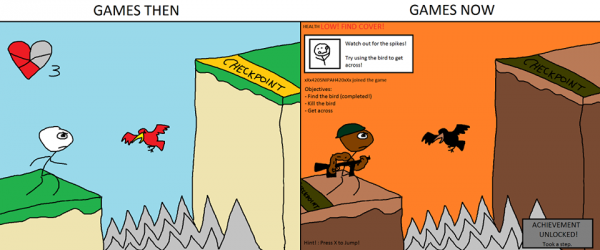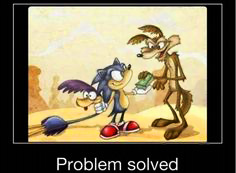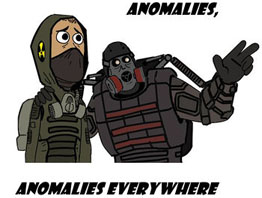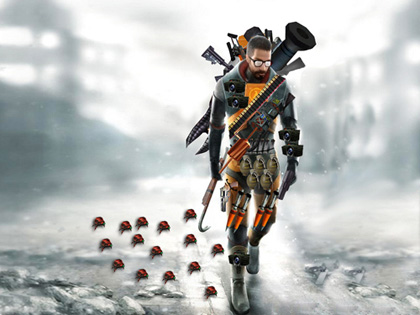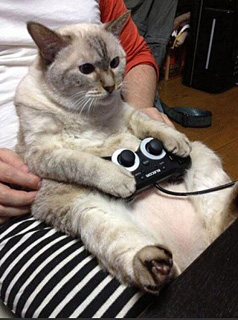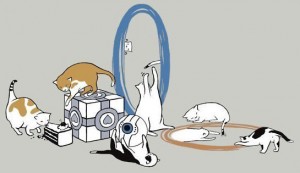| Home » Articles » >> Game Development » General Theory |
Archetypical Classification of the Video GamesPart-1:New theoretical vision, in addition to the traditional(analytical article, popular science)
The author – Dmitry Ghervas (scientist theorist, writer, game designer, philosopher, graphic designer) Facebook: https://www.facebook.com/ghervas.dt LinkedIn: http://lnkd.in/bcwr2GP
Forword by the author:Please excuse me in advance for this translation. I translated into English as I could. Perhaps in the near future there will be more high quality translation. This article I wrote during long time, throughout a long and difficult period. I edited a lot and introduced new entries. Please to treat with respect my work. Your negative emotions and inadequate thoughts please keep for yourself. :) – The first version of this article I published in September 2014. For nearly a year I significantly edited the article, I have added more information and subsequently have divided this article into two large parts, for greater comfort. Basic information is mainly in the first part. I hope that this article will be useful for you.
Introduction:The traditional classification of the electronic-digital games (they are also known as video games) is make commonly according to the interactive genres (shooter, slasher, racing etc.), artistic genres (drama, tragedy, melodrama, etc.). Also, is according to the scale of development, target audience or provided budgets – such as casual games, hardcore, indie (independent games) or mainstream, AAA, art-house. Such classification of the games will not disappear somewhere. However, from a scientific point of view, it is desirable to concentrate certain moments and identify those elements, which are at the base of the games, in order to facilitate the contemplation, the perception, and the analyze of games, by the amateur or professional, even if is beginner or more advanced.
Me, the author of this article, a year before writing it, I have start individually to create a 3D logical game from the first person view (code-named "Green Way"). From the beginning I conceived a simple gameplay and by idea, developing period should be around 3 months. At the beginning it seemed easy: wrote a design document (in which I added and edited something), I drew the schemes of the levels, I modeled levels and… already 3 months have passed, and then another 3… I exported the levels in the game engine, and made it possible to play at these levels – in an amount of 48. Has passed the Christmas and the New Year holidays, but the game was still in primary version, far from finalizing… I also made the menu which was changed a few times. Progressively and the first person view system I changed three times. Some of the main objects of the game I had to modify or completely change… Plus at all, during the development of the game, I was faced with financial and family problems, which succeeded to squeeze out of me all the creative energy. Over the past 6 months I fought with depressed mood, trying to do some work on the project – the development period has stretched to a full year and still no end in sight. – But what was the problem, in fact? The main cause is that from the start I had underestimated the complexity of my game project. I not only came up the certain mechanic and gameplay, but also have introduced the story (plot, subject) with the main character, in the role of whom will play the users. – Thereby, the game has become too complex and difficult to be developed by a single person. – Yes, now after the one year of development, the game can be passed on its logical levels from the beginning to the end. But there is missing another two levels (only assigned to the story) – together constitute the 50 levels! In addition, to the logic levels need to introduce the “checkpoints" and some three-dimensional objects. I had to split the period of development on the steps (phases, stages) and keep a special journal for entries, concerning the details of the development. – The problem is that such a complex project obviously can not be integrated into 3 months - a fact evident for me now, but was very vague and unknown from the start. Because I still have some game projects in the concept phase or primary development (plus the current game), I arrived to the need to analyze more details regarding the development of games, that in general led me to the urgent need to split the game by category – namely it was necessary to highlight some typing of games (then named as "archetypes"), to make it much clearer what represents by themselves each type of game, what could be the period of development of such type of game (even in the team!) which could be the public audience of the game. Some readers from a number of developers may also ask themselves – why the game, developed by them, that from the beginning seemed "so simple", already during the development process, is extended to such a long time? –In particular, there is one answer: you have not correctly evaluated the complexity of the game project, respectively, you have underestimated it a lot. This includes underestimation of the complexity of the structure of the game (both in general and in detail), underestimation of the story (plot, subject, if exists, of course), the test period, also the transition from primary and secondary versions (from "alfa" and "beta") toward the final version ("gold" release) – as a result, is total underestimation of the development period (from start has been seen very approximate and extremely vague). Another problem, no less serious, is that you have not decided yet, regarding the type (category, archetype) of the game. I would like to underline the fact, that this article has been written more objectively, mainly to help both the beginners as well as the advanced developers, who want to see his project more clearly, more properly prepare the development period, somehow close to reality. Also, according to their requirements and expectations for the project, to be able to detect the type, the category which could be attributed to their game, because in the process of developing do not make high principled changes, which could ruin their plans. First we'll review the traditional classification of the games that is known by most people. – Detailed:
The traditional classification of the video games:When we hear about the classification of the video games, the first thing that comes in the mind is the genres of games, such as "racing", "shooter", "slasher", "strategy", "platformers", „sports simulators”, „arcades”, „RPG” etc. Especially, these genres represent a type of interactivity that predominate in some games. Notes: We will not stop to such genres - there is enough information sources, regarding every genre interactive separately (see in the Internet!) Also, do not forget about the traditional classification of the artistic genres: (the basic) comedy, tragedy, drama, romance, tragicomedy; (others, mainly by settings and styles) action, thriller, horror, satire, parody, detective, adventure, epopee, the mystic, western, post-apocalyptic, science-fiction (sci-fi, SF), fantasy, gothic, steampunk, dieselpunk, cyberpunk, noir (noire), fairy tale, myth (mythologie) etc. These genres exist until now on the basis of any artistic works of the theater, cinema or interactivography (-the art of video games). Notes: Some of these artistic genres have common tangents, can be combined; sometimes the classification of certain artistic works can be difficult and vague. The description of these genres can also be found in a variety of information sources. For several years, there is still a significant classification of games, known by so major categories such as "casual" and "hardcore", "indie" and "mainstream". A separate and more special category represent "art-house" games. – Here we will focus for more details.
Casual: this is simplest, "occasionally" games, in which you play especially to spend your time (seated somewhere & waiting for something etc.) or have fun from time to time; usually such games are very small in volume, they have a simple game mechanics and gameplay, and tasks in them are also very simplest; created for the widest possible audience, which is composed mostly from novice players (such as “noobs”). In general, "casual" has a kind of principle – you play once in a "simplest" game, then "forget about it" and quickly focus on another casual game.
Hardcore: this is the games pretty advanced, regarding the gameplay, the game mechanics, the missions and the tasks for accomplish; are oriented to the widest public, but which largely consists of advanced players, skilled for several interactive genres and which already have some personal preferences for some of these genres. Hardcore amateurs are tempted especially to largely study the preferred game, to create community of players with similar preferences, to play in groups or to exchange of experience. Notes: generally, the "casual" and "hardcore" represent some types of games based in particular on the complexity of their structure. The so called "indie" and "mainstream" already represent a separate category, based on the attitude of developers to the method of game development.
Indie: independent games + independent developing; it is actually a separate sector in the gaming industry, as well as special types of games, developed exclusively by the small studios, consisting of one or more developers. A special characteristic of "indie" is in almost total independence from the gaming public and especially from publishing companies (publishers) – most often are independent in terms of finance, and also from intervening from the outside in the process of developing. "Indie" studios mostly can afford to experiment freely with the new game mechanics, methods of interactivity and types of gameplay.
Mainstream: separate sector in the gaming industry, as well as types of games, associated especially to the most popular interactive genres – it is as though "serious games", usually with budgets of millions, oriented both the casual amateur and for hardcore players. Such games are created especially by huge companies, owning with several studios. In one team at such mainstream games can work from 50 specialists up to 150 and more. Concerning the game development, the "mainstream" companies mostly focus on the most popular existing models of game mechanics and gameplay types, but the experiments in this direction are very limited. The development of a mainstream game much depends on the budget + the time allowed, as well as on the opinion of the company administration. The chiefs (whether investors, managers, producers, directors of different levels) can actively intervene, practically at any stage of developing, changing something, far as they have enough mind (if at all is "enough") or how "says another chief" or as it is something in trend or what says the community of players, etc. Those games are traditionally divided into "AAA", "AA" and "A" – where each "A" represents an additional zero (A 000), attached to the budget amount, which is spent for development of one game (AAA – i.e. 1 000 000). Of course, to the "indie" games also can be attributed the classification by budgetary scale. But the budget of the many "indie" games never reach the first "A".
Art-house (works “by the author”, artistically more especially): such games represents primarily a form of expression of artistic, aesthetic and philosophical vision of the author of the game (whether it be a screenwriter, game designer or another developer); initially are not intended for a wide audience (although could become very popular) are focused on those people who knows a lot about the overall artistic and aesthetic elements, but which are also able to analyze more unknown gaming works, to perceiving the ideas that are often concealed by the author. As "art-house" can be called some "indie" games, and more rarely, some of the "mainstream" games.
So, as casual games can be called the following: "Angry Birds", "Solitaire", "Tetris" (!), "Space Invaders", "Pac-Man" (!), "Breakout", "Floppy Bird" and the same similar, plus various games at their level (mainly by the level of gameplay). There is also a problem, in the fact that a lot of games, which are called as "mainstream" (where, for example, in some shooters often just need to run and shoot, where the subject is only as a background and game mechanics is mainly copied from the other, more popular titles) seem to be suspiciously simplest, than many casual games. The game mechanics of so-called "hardcore" games from the "mainstream" sometimes is strikingly similar, from game to game, becoming a victim of stereotypes that "float in the bath" of popular interactive genres (especially I would to highlight the shooters, strategies, racing games). Over the years some game series as though not even going somehow to change at least their mechanics, "hanging in time". Even worse is when the plot (subject, story) and gameplay seems to remain similar, without changes. Therefore, we find cases when the hardcore game amateurs strongly criticize some series of games (especially of mainstream) that gradually are no longer able to impress and attract the public. How then could to classify those games? On which "shelves" to place them, to be clear what type of game it is and from which category? Well – me personally, the author of this article, have already answered for myself to these questions. Concerning the categories of games, I have found a solution, analyzing and classifying them, according to their basic criteria. These categories I called as archetypes.
Notes: These categories may also be named as models, types, kinds, but I think that the term archetype it fits best, is more scientifically, seems to be logical enough and, moreover, sounds pretty good (is cool, as if to say, more concretely). :) Archetype (definition of the term): the primary model, the initially type, based on which you can to orient; the model (of some concepts in the domain) formalized and reusable; archetypical, archetypal.
The Archetypes of Video Games – Classification:To each archetype I gave as much as possible clear and simple name (title) – all for the most rapid perception, for more adequate and logical understanding! So, the video games are classified according to the following archetypes: 1. Simple Archetype 1b. Simple-Medium Archetype 2. Medium Archetype 2b. Medium-Advanced Archetype 3. Advanced Archetype 3b. High-Advanced Archetype As you can see, have a right to exist such games, which have mixed archetypal characteristics, either between the simple and middle archetype or between the middle and advanced. Notes: Under these archetypes I put some titles of games, which, in my individual opinion, may relate to them. Another thing is that each game archetype has its own period of development. Moreover, each archetype has its public (the audience) composed of members with a certain gaming experience. For example, some people are good in the simple games, but have no clue how to play in more complex games. Of course, it depends on their interest about variety of games, and also on their gaming experience. Also, it should be noted that modern games are complex artistic works, and in addition to the game design and game mechanics, may have some important elements, such as the story (with some characters), skill & bonus system, etc. When analyzing the games it is necessary to regard these elements. – Further in detail:
1. Simple Archetype – without a story (neither background story!), persists a very simple game mechanics, which consist of repeated actions of the same simplistic mechanics, respectively of the same actions; there is no bonus system or skill system. Game titles: such as "Pong", "Space Invaders", "Tetris" (initially), "Miner", "Solitaire", "Floppy Bird" (initially), most of sports games, simulators, such as racing, that not have plot (story) at all; also many of 2D games on the portable-mobile devices (-already, you personally can do the analysis of certain games in order to detect them). The period of development: an average from one to two weeks, to one or two months. The audience (public): is enough to have the experience of a novice player, mainly casual; represents the majority of people in the world, such as kids from 3 years old, school-age children, the elderly people or housewives. Represents a very large audience, in fact, it is the largest existing public of players!
1b. Simple-Medium Archetype – there is only background story (plot, subject), and there are one or several fairly simple game mechanics (run, jump, throw, shoot, etc., but without any complications), a very simple bonus system; can exist a simple skill system; there are no changes of story during the game (i.e. during the game on the levels, in-game), and the protagonist (main character), or the team of protagonists are doing (performs) only simple actions of simple game mechanic, often repeated; these characters not meet other characters on the levels for certain discussions or receive new tasks from them. Game Titles: "Angry Birds", "Pac-Man" (exactly here!), "Quake-3: Arena", "Unreal Tournament” series, "Star Wars: Battlefront-1, 2", "Cut the Rope", many strategies, etc. The period of development: an average from 3 months, up to half a year (sometimes more) The audience (public): is enough to have the experience of a novice player, mainly casual; represents the majority of people in the world, such as kids from 3 years old, school-age children, the elderly people or housewives. Represents a very large audience, in fact, it is the largest existing public of players!
2. Medium Archetype – may persist several of more advanced game mecanics, often mixed between them (see fighting games, shooter, slasher); could be a more advanced skill system (not necessarily), plus more advanced system of bonuses, often related to skills, possibly can exist a sale-purchase system (again, not necessarily). It is more important that such game may have a background story and the in-game story (i.e., that is detected during the game on the levels), but more weak, that also has a weak hint (allusion) of perpetuating (disclosure) of the story during the game. Game Titles: "Unreal-1 Gold", "Quake-1, 2", "Doom-1, 2", "Star Wars: Jedi Power Battle", "Mortal Combat” series, "Virtua Fighter” series, "Virtual On” series, "Dead or Alive” series", "Minecraft", „Need for Speed: Underground” series, almost all fighting and slasher games, etc. The period of development: an average from 6 months, up to one year. The audience (public): obviously that is required a little more gaming experience, than of the novice player – the user is interested to explore more game genres, and in the meantime, is formed his taste, the concept, opinion on certain genres and game mechanics. Such players can not represent the majority of users, but they are good distinguished among those, who just beginning to play. Can be assumed that they represent the average number of players, but these players are clearly more by number, than those who play RPG or adventures with wide large story (plot, subject).
2b. Medium-Advanced Archetype – as well as the medium archetype (there could be more advanced game mechanics, often mixed, a more advanced skill system, plus bonuses, buying-selling system). Basically, an specific more special consists in that, there is more advanced story (plot, subject), both as background and one in-game; the protagonist (in the "skin" which we play) can meet on the level other characters for certain discussion, but this can not result in receiving of new tasks missions or to the appearance of new missions – so, without quests. Instead, often in such games can be meet (find) so-called "bosses" who can tell us something, declares something – our protagonist may “respond” to them in some way, and the battle with the "boss" often leads to radical, serious changes of the in-game story. In addition, the actions of players on the levels can also lead to major changes of in-game story (serious events take place), for example – if we succeed to destroy an military outpost, this will impose that an "boss" for come out to the open battle or our "chiefs" will contact us personally to praise and to advance us to a new rank, and then we receive new weapons or a team for assistance, plus a new mission from the "chiefs" (– in-game story variants can be very much). Game Titles: "Call of Duty" series, „Battlefield-3”, "Halo-1, 2", "Portal", "Bulletstorm", "Virtua Cop” series, "Doom-3", „Star Wars: Republic Commando”, etc. etc. etc. The period of development: on average from one year, up to two years. The audience (public): it requires more advanced gaming experience – although the user is interested to explore more game genres, but his tastes have already focused on specific genres and game mechanics. They may represent a large number of players, however they are less in number, than casual players.
3. Advanced Archetype – (more advanced game mechanics, often mixed, a more advanced skill system, plus bonuses, buying-selling system). The main game story includes (supposed to contain) the meetings with other characters, both for discussion, but also to receive new missions and tasks from their (only as a supplement to the main story); such additional missions (quests) can not represent a separate story (plots). I.e. there can not be the "nonlinear" story – there is only one main "linear" story, with simple additions of missions. Most frequently, any added mission-task (quest) can not influence to the main story. In the game can exist only one final (a single end). Notes: In some games is quite possible the existence of secondary quests, in which the player can be or in the role of the protagonist, or and in the role of any other secondary character (and there can be several main characters). Besides, "the change" of the character can be done before entering on the level, or already during the game on the level, or such "change" is happening automatically and is included in the main story. Game Titles: "Killzone” series, "Half-Life" series, "Quake-4", "Portal-2", "Crysis" series, "Unreal: The Awakening", "Star Trek: Elite Force-1, 2", „Far Cry”, other advanced 2D or 3D games. The period of development: on average from 1-2 years, up to three years. The audience (public): it requires the advanced gaming experience for a long time. Can represent a large number of players, but less in number than the casual players or with average experience.
3b. High-Advanced Archetype – a variety of advanced and even quite complicated (sophisticated) game mechanics, often mixed; also there could be a very varied skills system, and the most advanced system of bonuses (which often is an integral part of the skills system). In this category can be two types of story (plots, subjects): A. Story-subject moderately nonlinear: the main story obligatorily has branches, ramifications (quests – additional missions, which the player chooses before entering on the level, or already on the level during the game) which do not necessarily have anything in common with the same basic story. The game can have multiple endings, finals (but not necessarily!) depending on the one, single path, that the player choose for himself, or depending on the various decisions, made by him throughout the entire game. B. Story-subject totally nonlinear: there is a lot of ramifications, which have only the beginning from the setting of the game (about setting read somewhere individually). Some kind of main, basic story in principle does not exist. Also, there is no the main or secondary missions. The totality of missions (usually unrelated quests) make up a conglomerate (of different stories, situations and cases) that can be called as "common nonlinear story" (or just “common nonlinear subject”). Game Titles: "Shenmue", "Dishonored", „GTA” series, , "Far Cry-2, 3, 4", "Deus Ex” series, "The Walking Dead" series, "Fahrengeit", "Heavy Rain", "Beyond: Two Souls", "S.T.A.L.K.E.R.” series, „World of Warcraft” series, „Metro-2033” series, etc. etc. The period of development: on average from 1-2 years, up to 3-5 years. The audience (public): it requires the advanced gaming experience for a long time. The amateurs of such games might represent more narrow public and they are obviously less in number, than the amateurs of games of the simple or medium archetype.
Notes: 1. – The period of development, in any case, can be estimated approximately – much depends on the number of developers in the team, and also it depends on their level of experience and professionalism. Therefore, the period of development can be estimated more accurately, only if such team already has a project-game previously completed. Then you can to analyze the work done and to evaluate more or less (but also approximately!) the period of development for the next game. – Do not be too strict! External and internal factors in any way affect the period of development. 2. – Although are estimated objectively, the data regarding the Audience (of each game archetype) are quite general and are only based on the generalized observations – however, more studies are needed for statistics. 3. – As well, the number of players and their experience should not be confused with the popularity of certain games or genres of games! 4. – If there is a necessity and a desire to attract more players to the games of advanced or high-advanced archetype, then during the development, in such a game is quite possible to introduce the elements (like logic puzzles, different game mechanics, etc.) from the more simplest games, such as the casual games, arcades from a simple or simple-medium archetype (or to invent something completely original, but with a more simple manipulation). – If this is done logically, taking into consideration the main features of the main game, then these simplest game elements may well to beautify (to decorate) this same "big" game, that is being developed. For example: “Shenmue” series (!!! – which is full of extremely varied game elements and to describe all is impossible here), “Deus Ex” series, “GTA” series; partly “Doom-3” (the element “gaming arcade machine”), “Star Trek: Elite Force-2” (the elements “logical solution to connection of electrical circuits" or "hacking of security systems” etc.), “Chrome” series ("hacking of security systems”), also “Call of Duty” series, “Battlefield” series (some elements such as «quick time events» at the battle face to face, certain arcade moments such as "waves of enemies soldiers", "zombie waves", "arcade shooting while driving or flying with a fixed machine gun," or even a change of roles, like "gameplay as dogs" or "as a pilot" or "as semi robotic drone" etc.), “S.T.A.L.K.E.R.” series and mods (the extraction of artifacts from anomalies, hunt for monsters and various mutants-animals, logical moments with making the radio-electronic warfare, varied crafting of necessary items, simple purchase-sale systems available with anyone, simple scientific measurements, sometimes with taking of samples for analysis, extraction of medicinal herbs, the logical moments at looking for ways through the anomalies-teleporters etc. etc.). – In short, you can have a lot of inspiration! -)
Tangents:Perhaps, some pretty skeptical person will ask: "Why such classification is needed?" Well, let's give them an example (jokingly and seriously) – let's say that in one studio, a few young developers were gathered in a team with the idea to make a "cool shooter". So far, they don't have the experience in creating of shooters. They begin to conceive something ... a year has passed and discover that what they have done, is very far from that "ideal", which they had imagined. OK and they again started to work. Another year has passed, and then another year, the game already seems to be almost finished, but again "it is not quite that we would like". What then need to do? From the publishing company (which has signed a contract with this studio) comes a project manager to help them – to see what can be added something, or to be more edited, or what to throw something completely etc. Another year passed and that ideal is nearly reached, and now almost close to "that ideal". But testing of the game (made by the team of testers, of course) shows that the game has a lot of bugs, AI is very stupid and the graphics is horrible. Besides that, the "nonlinear" story is so tangled, that is not clear in general what to do in the game, and the menu is "total garbage". Finally, the last condition is that for one year to eliminate all the shortcomings of the project and to finish the game. Another year has passed and finally we see the "freshly-obsolete" game on store shelves or in online stores. Millions of players, who on hold "stayed hungry", now buy the game, and after a while, a lot of them loudly declare "that it is not what they expected"... – Oops, already this seems to me that is another matter ... or not? -))) Anyway, you do not think that this story is a bit known for you? And what is the problem of those poor developers? – Okay, you almost guessed it – yes, the developers before the start of development had no idea what type of game they started to make. And during development, this game seemed to be as a cloudlet that hang in the air and constantly changing its shape, so that in the finally, when it was finished, to arrive at the fact that the players themselves did not understand "what the hell they see in front of them?". And that does not happen such silly stories, from the start should to find those analogs of games, which to some extent (which somehow and with something) might have something in common with your future project. Respectively, you just need to select the game archetype, which is required for this project, and then the decision will no longer be changed. – And in order that do not arrive to the state «to float in the air , like a cloud and constantly changing its shape".
Hey, but regarding the sequel or prequel to the already created game? How about them? I'll give you an example (again jokingly and seriously): a certain studio for two years has created a shooter that was sold not bad, although its realization was not too brilliant and not with big success. But company-publisher, which owns this studio, has decided that it is necessary to make a sequel (continuation) of this game – but "something more cool". And instead of that to create a simple same shooter, they have implemented a system of RPG and "nonlinear" story (probably in their opinion it is "more cool") - thereby, they completely changed the concept of the game, as well as the form of storytelling (i.e. from the linear story they switched to nonlinear – most often happens, that a person who speaks about a nonlinear story, not being himself a professional screenwriter or at least a game designer, then most likely this person in fact has no idea what he is talking). Approximately after a year, "the heads" of the company have come to try "with the teeth" the game that is almost ready... – "OMG, holy sh..!" – It turned out that this is not what they expected!.. And they are beginning to analyze something, make a "brain noise" (already here follows a kind of common monologue): "– Damn, is not at all what we wanted! – Something with this game is not normal... Perhaps should remove some weird game mechanics that were so charming in the first game, but which not combinable at all with our adorable nonlinear story for sequel. And this protagonist is somehow lousy. No, what he does here at all?! He's from the first game! Remove him to hell! And in general, put at least three characters to choose from, to make it more fun – their sex and orientation does not matter... Don't worry, the heroism will already show the player by himself... No, wait a bit – is better if the player himself would have created his character at the beginning of the game ... and that also could choose the clothes. It's finally somehow even more cool!.. Ah, yes – let the player with points or money to buy various rubbish, more or less needful. Well yes, it would be cool! Hey, maybe we will knead a Free-To-Play?.. No, wait - what if a player could buy the game with the money, and then within the game have already to buy different little things. Cool, huh?! And bucks will spill like from the sacks! Yeah, but what?!.. What do you say – that the story is bullshit?.. Just give it to hell. Do not bother – if there is even more widely and nonlinear story, then it will be better for all of us – would be reason to push items for real money...". In short... for developers themselves start a "great madness". Ordering to remove the main game mechanics who "migrated" from the first game, "the heads" gave indications to change the whole mechanics, to make the story "much more nonlinear" and with absolutely different characters. So ... a year later they have tried the game "with the teeth". And again came out "the hell knows what"! "– OMG!.. What the he-e-ell is tha-a-a-t?!.. What should we do with this crap???" Still, you do not seem that this story is a bit known? – Unfortunately, such examples are not at all few. And some of them are quite sad.
But here I have another question: "How much a person must be an idiot, to completely change the concept of the game for the sequel" -)) The answer is the following: if the first game is not the best and most popular, then to the creation of sequel (or prequel) should not "to jump" from a game archetype to another or radically change the initial concept of the gameplay. And especially not worth to insert a "nonlinear story" in sequel. And if you heavily want to completely change something, so let it be NOT a sequel, but a completely different game. But regarding the very well-known, very popular and widely promoted brands (whether gaming brands or made by movies), such as "Halo", "Killzone", "Sonic The Hedgehog", "Super Mario", "Star Wars", "Star Trek" etc., in this case can be quite acceptable the total change of the archetype and the concept of gameplay, or form of storytelling. However, it should at least to experiment with initial forms before starting a serious game production. The risk is big, but the brand itself could enough to smooth the failure. Then it should to experiment further, until another success will come. However, the original concept of the game brand (for this time namely the game brand, but not created by movies) will always remain as a standard (ro.–etalon) – almost classical.
About some games, included in the list, can appear questions concerning their belonging to certain archetypes. For example, in game series "Half-Life" we see more a background story and a quite simple game mechanic in the interactive genre "shooter" (with very lightweight RPG elements). And in the "skin" of the protagonist Gordon Freeman often we need to solve certain tasks, besides the fact that you always have to go somewhere and to shoot that what stops you in the way. On the other hand, generally there is no a skills system or even an advanced system of bonuses. The unique "bonuses" are those that you find on the levels, such as ammunition for weapons, the stations for filling of health and of energy (paradoxically, in this game the "energy" actually means "the state" of armor suit in which protagonist is clothed) etc. Well, how would not be strange, having a simple game mechanics, as well as a certain story, which is more like a background, it should be noted that this game has very advanced general gameplay, associated with a variety of situations-tasks which should be solved, in order to pass further to another location. In addition, all the situations in the game are dictated by a well-developed story, even if seems that it looks more like a background than the in-game story – just the story in no hurry to be fully disclosed. Do not forget that on some levels we meet the characters, who not only speak with the protagonist, but also help him with something, accordingly, they are very active, and their actions directly disclose the story. So, in general, the game series "Half-Life" can enter in the ranks of advanced gaming archetype, but more likely being at the initial "border" line – something like the transition, from the "medium-advanced" archetype to "advanced". Another example is the game "Pac-Man". – This game is not part of simple archetype? – Actually, no! Because there are bonuses in the form of different fruits, and if you "eat" these fruits, then you get extra points.
Conclusion:Some novice developers ask me about how to create the perfect video game. I answer that nothing ideal can not exist, because something ideal is like a dream, something imaginary, to which you can aspire, but more often can not be achieved. Therefore, you must make Not an ideal game, but a correctly game, compositionally logical. I mean that in the game everything should be in its place, balanced, and is desirable that all the elements to be combined good between them more correctly, harmoniously, to be clear why you play, how to play and for which public-audience is intended. Of course, the gamer should have a good motivation, in order to move right up to the final of the game – and about this, developers must to think very well on the story and gameplay.
Another question that is often addressed to me (mostly on Facebook), it's just about how to make good video games – yes-yes, namely the Good Video Games. Pretty vague, is not it? One of my answers to such questions is in the following way (although here is more detailed): – So, all of us know that the video game is a program (application, soft), working on special computer software codes, on the basis of programming languages. Also, let us recall that the great contemporary art, namely the cinematography is... what? – Is movement! – Namely, the movement of the frames with a certain frequency, which creates the illusion of moving images on the screen. I.e., these program codes or movement of the frames and of image is only some technical details. Although this is a very important details, of course, but is no more than some details. If those technical details have been enough, I'm afraid that the movies and the video games in their present form most probably would not have existed. I.e., all these details would be reduced to some attractions, whether be filmed movie attractions (some simple video filmings, documentaries or with special effects) or interactive (something similar to simplest games or something with more or less advanced game mechanics, as it was at the time of appearance of the first consoles, but probably with better graphics). But only the human spirit, that understands and creates the art, can to materialize these technical details in a work of art (artwork, piece of art). The Lumiere brothers, at their factory which was invented the device сinématographe (i.e., specifically, it was a highly advanced device for those times, which could to make a filming-shooting on a special film, and then from the developed film, to show the image on the screen), shows a simple filmed scenes from the life or something improvised, as an attraction for the public. But a film director had to appear (namely George Méliès) then that to materialize these rapid movements of the film frames into artistic films (movies, motion pictures). Together with the works of other film directors, all this eventually have led to the art of cinema, known as cinematography. With the electronic-digital games was almost the same story – had to appear the people of art, or just people who love the art, in order to their efforts, embodied in the interactive works, have led to the emergence of a greatest modern art – the interactive art, also called interactivography. At the present time, confidently and openly, we can talk about such a cultural phenomenon, in which is reflected its documentary and artistic side. – We play games in which can be a story or only game mechanics and all this exists on the basis of a certain theme. For example, the game on the theme about the war, where possible only need to run and shoot in certain historical places and dates – i.e., this is the documentary work. But there is also artistical works on a similar theme, in which it tells about the fates of people, about their characters, relationships and struggle with difficulties, etc. Respectively, the games there are on a very different themes, stories, game mechanics and gameplay etc. So... if you want to create good games, you must first understand a simple but important truth – the video game is not only a software product. The video game is also a form of art, so it is a product of art (respectively, a piece of art), in the truest sense, which are the movies and theater performances (fr.-théâtral spectacle). The video game is also a unique cultural phenomenon in its own way, with its special interactive artistic language. Accordingly, you should be able and to know how to write different stories, scenarios, how to do the directing of games (ro.– regia de jocuri; as a game director, he also is the game designer! – i.e. that who make the processing of the literary scenario of the game, in order to create the directorial game scenario, separately - it's basically the same gameplay!; + invents the game mechanics and make the design document, which includes a detailed description of the game), also you should be able to work with 2D or 3D graphics (drawing, modeling, 2D and 3D animation), to make audio-video-photo editing (and various types of image processing for textures, special effects, cut-scenes, etc.), to make programming (by writing codes based on a specific programming language or make simple visual programming), level design (i.e., a full creation of game levels, from the ordinary arrangement of the game objects, to a virtual natural or urban environment + introduction of ready-made interactive objects and characters to create a game action, based on the designer-director's instructions), work with the actors-characters (virtual or alive, again as a director + designer-animator, for cut scenes and various animations, such as movie-capture, etc.), an so on. And if you can not do something from all of this, then you have to start working in a team – for example, to create a studio and find a skilled and preferably professional people to assemble a team of developers, paying all of them (yes-yes, because with the naked enthusiasm will not go far away), be able to communicate well with everyone, able to listen, to give and take advice, give instructions. Or just to enter into the team of another studio and "plow the ground" for other people, and along the way learning how to make good video games – but all of this are already your worries. Such are the things! By the way, to work in a team is more cheerful and faster, so it's time to learn how to be a good, wise manager and employee. ;) So, now to the finale of the first part of the article, I would like to underline that this classification of the video games at the beginning I invented for myself personally, to simplify the understanding of the video games, and in order to work more easily on my own projects. Gradually, I came to the conclusion that the importance of this classification far exceeds the personal need, and this prompted me to write and publish this article. I really hope that the article will be useful for game developers, journalists and for other specialists from the industry and art of the games.
Also: "Archetypical Classification of the Video Games"Part-2: "The Essence of the Games"– very soon will be a complete translation – a bit of patience, please.
"Game Design: the revealing of phenomenon" (previous article of the author) "Interactivography – the new scientific term or The manifest of love for games" (previous article)
Information and contacts: Facebook: https://www.facebook.com/ghervas.dt Twitter: https://twitter.com/DmitryGhervas LinkedIn: http://lnkd.in/bcwr2GP GameTalents: http://www.gameplaytalents.com./talents/detail/game-designer-writer-cg-designer E-mail: ghervas-dt@mail.md | |
| Views: 909 | |
| Total comments: 0 | |



